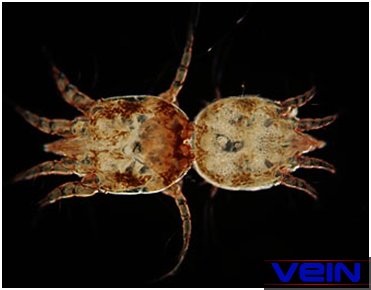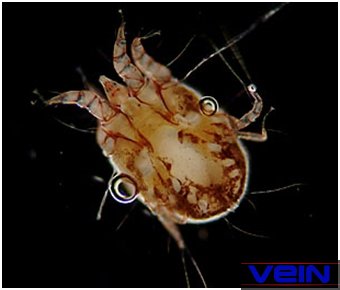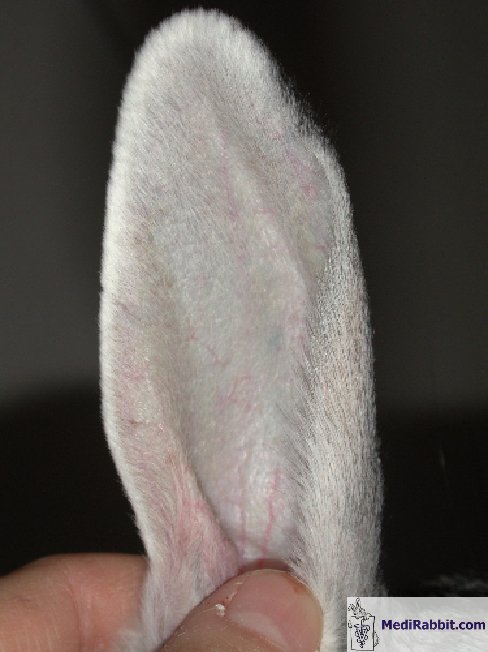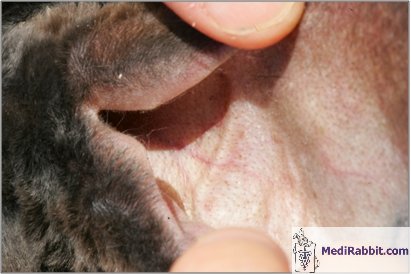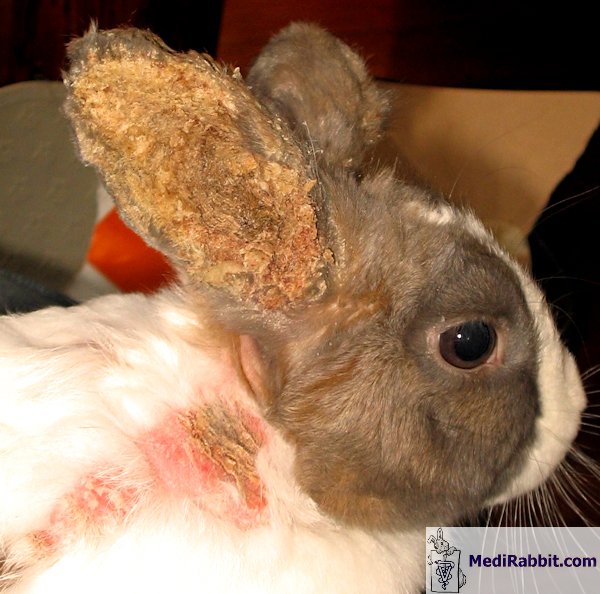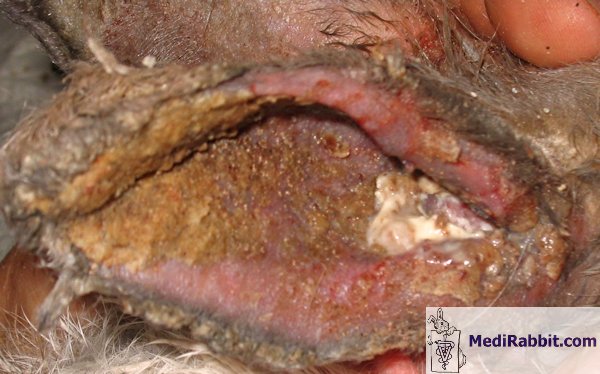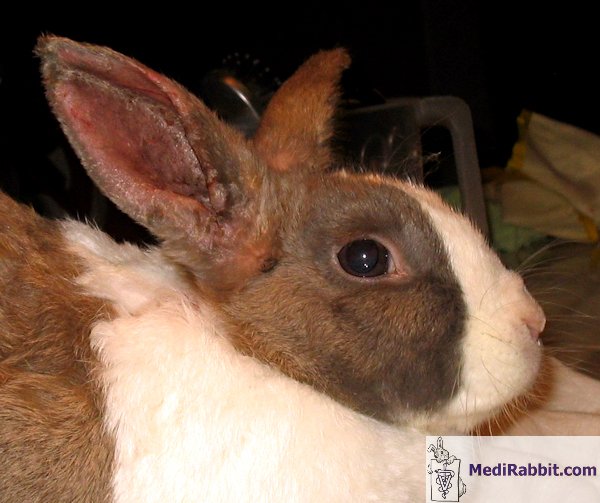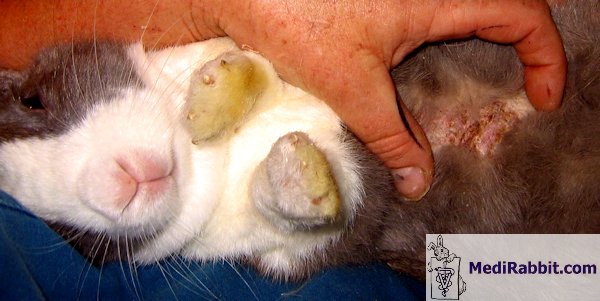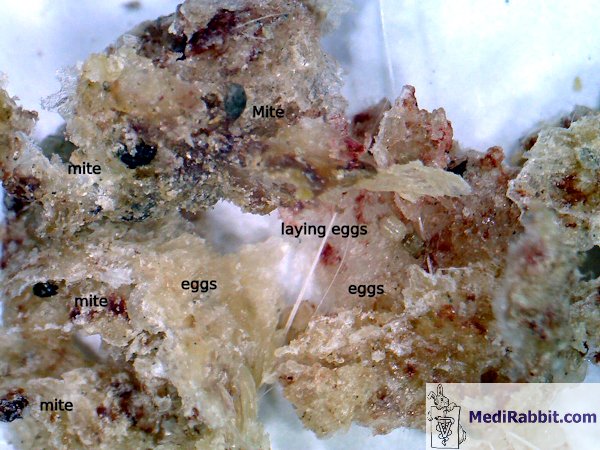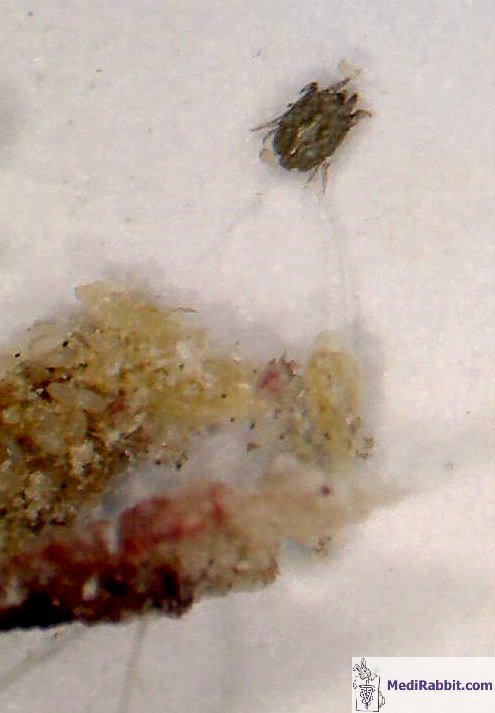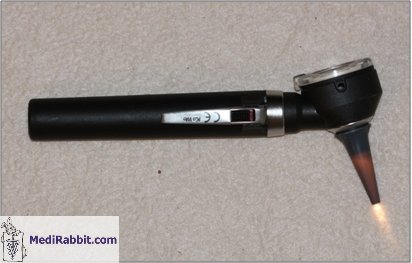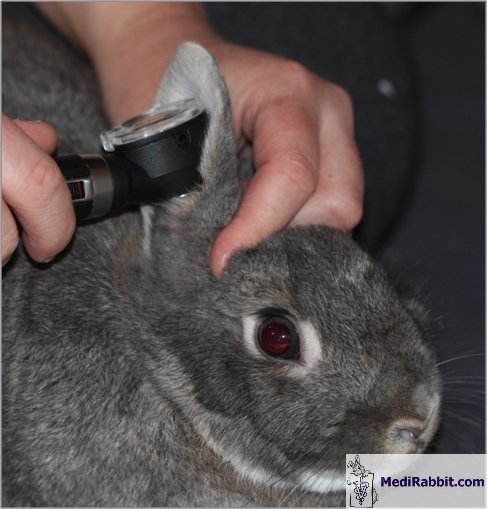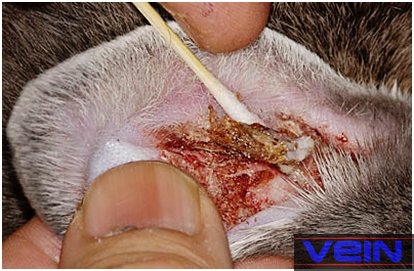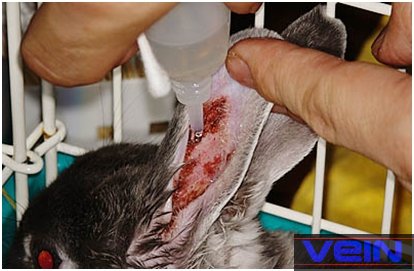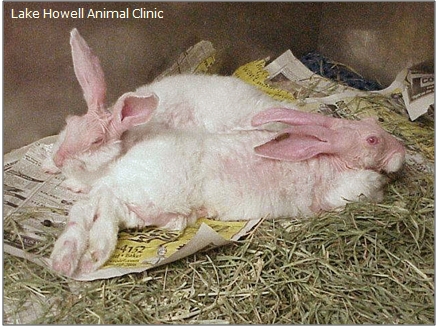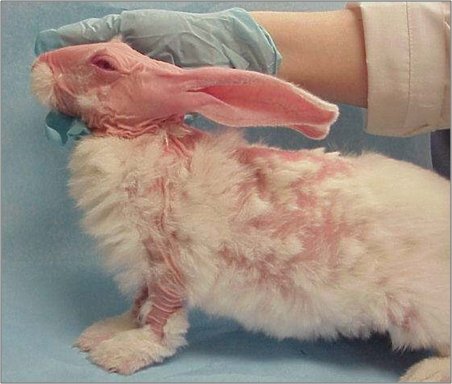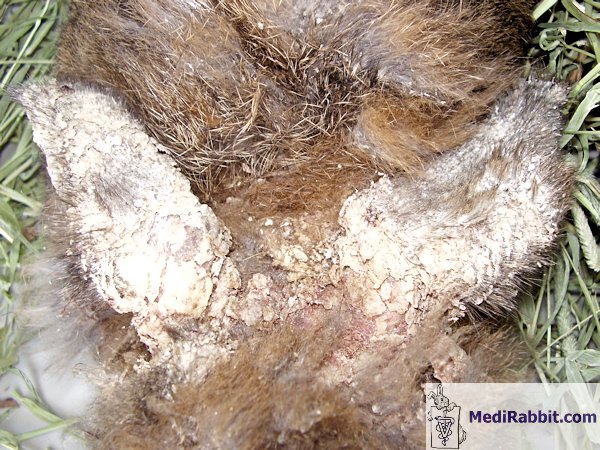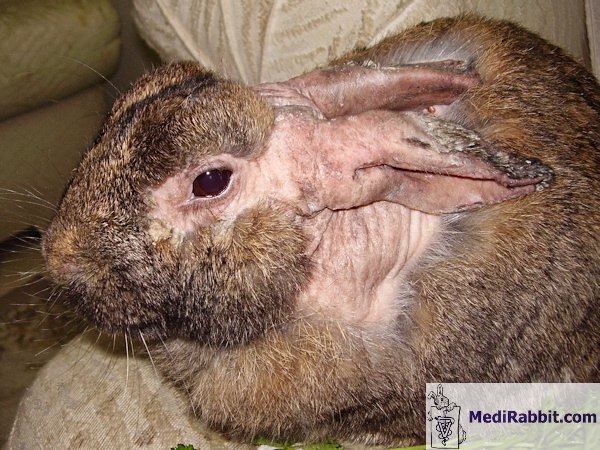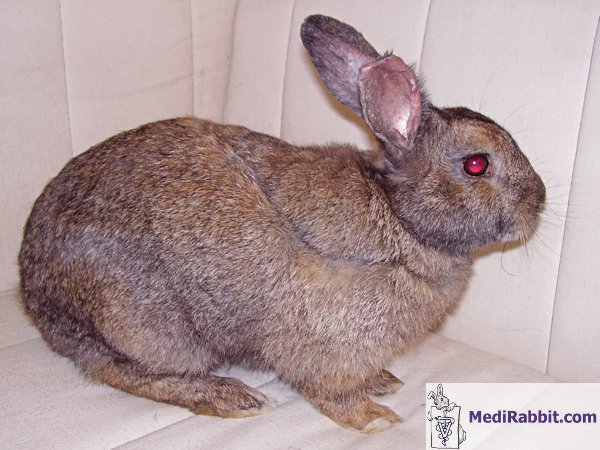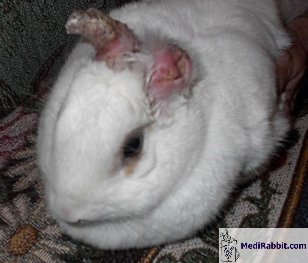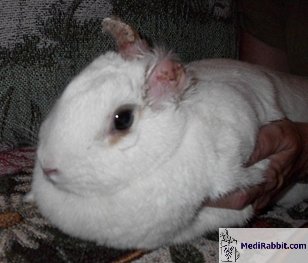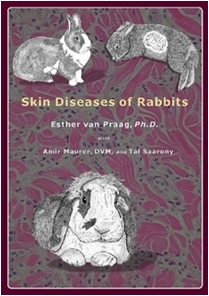Ear mite: Psoroptes cuniculi
Esther van Praag Ph.D.
MediRabbit.com is
funded solely by the generosity of donors.
Every
donation, no matter what the size, is appreciated and will aid in the
continuing research of medical care and health of rabbits.
Thank you
|
Warning:
this file contains pictures that may be distressing for some persons
The
rabbit ear mite parasite Psoroptes cuniculi is a cosmopolitan
parasite. It has different life stages: egg, larva, protonymph,
adult mite. The cycle lasts about 21 days, depending on environmental
conditions, with eggs hatching after 4 days.
Psoroptes
cuniculi is mainly found inside the ear
pinnae. It is not uncommon that only one ear is affected. In older or sick
animals, or if not treated properly, the parasite can spread to other regions
on the body, and infest the head, neck, legs, ventral abdomen, and perianal
region. The mucus and fecal material of the parasite induce an inflammatory
reaction that leads the rabbit to scratch its ear. The blood that comes out
of the scratched lesions serves as a source of nutrition for the parasite.
Symptoms and clinical
signs
Itching
ears, frequent shaking of the head, and scratching up to the stage of auto-mutilation.
In the beginning, small, tightly adherent skin scales appear deep in the ear
canal and the earlobes and are surrounded by alopecic (balding) regions.
Those yellow-gray scales can become rather thick. They carry large numbers of
the parasite, mite feces, skin cells, and blood.
If no treatment is started at
this stage, the scales will grow into crust and may reach a thickness of 2 cm
in extreme cases. The ear is no longer able to stand up, and droops. The
scales/crust should not be removed; if removed, they
leave bloody eroded skin. The crust will fall off within 10 days after the
first administration of oral or injected ivermectin. Earlier removal is also
very painful, and may lead to screaming.
Video
by D. Hanson Secondary
bacterial or fungal infections are observed. If not treated, the bacteria
will spread and cause hyperkeratotic (abnormal thickening of the skin), otitis
externa (outer ear infection). If left untreated, the infection can spread
deeper in the ear, causing the rupture of the tympanic membrane and
subsequent inner ear infection. This can be accompanied by head-tilt.
Diagnosis
Diagnosis
can be difficult and visual examination is not always sufficient to confirm
the presence of ear mites. Detection methods include the tape method, skin
scraping (shallow if fur mites are suspected, deep if burrowing mites are
suspected), or the vacuum aspiration method on a filter paper. Samples from
scraping or aspiration should be spread on a microscope glass, dissolved in
KOH, and examined under a microscope. Great is the chance to see at least one
mite or a larva or eggs. Fur can also be sampled, dissolved in KOH, and
examined under the microscope for the presence of eggs. If no mite is present
in the first sample, other places on the body should be checked. If the
presence of burrowing mites is suspected, but none found after a deep skin
scraping, a biopsy on the area suspected of mite infestation is advisable.
Treatment
The scales/crust should never be removed !!!
Removing them is horribly painful
to the rabbit, leading to screaming (see video).
Ear mites are effectively
eliminated by avermectins:
• Ivermectin:
0.4 mg/kg, PO (oral) or SC (subcutaneous injection), 3 times at intervals of
14 days (life cycle of Psoroptes cuniculi is 21 days); 0.2 mg/kg has
been found ineffective.
• Selamectin: Revolution® (US) or Stronghold® (Europe) -
Pfizer, 6-18 mg/kg. A single topical (local) dose should be sufficient; if
not, repeat after 30 days. If the affected rabbit presents severe anemia, a
transfusion of blood can be attempted from a healthy donor rabbit.
• Moxidectin (Quest® or Equest® -
Fort Dodge). Secondary effects have not been observed when the medication was
administered orally, on the contrary to subcutaneous administration.
These
avermectin compounds are non-ovicidal (will not
kill the eggs), but the drug remains in the tissue long enough to kill the
larvae that emerge from the eggs. Ivermectin diluted in mineral oil, applied
directly on the ear, is less effective than injected or oral ivermectin.
The
use of over the counter products against mite or ear mites should be avoided.
Most contain pyrethrin. While one of the least toxic insecticides for animals
and rabbits, pyrethrins/pyrethroids
are neurotoxins which lead to continuous "firing" of nerves.
Observed problems in rabbits include limb paralysis, seizure, coma, tremor,
sometimes death.
Many
of those products contain additives that prolong the effect of the pyrethrins, and inhibit the breakdown of these products
in the body. They can lead to toxic reactions in rabbits. Piperonyl
butoxide is one of them. If no immediate death,
there should be **slow** recovery with time, around 48 h. Ear mite
infestation is accompanied by pain. An analgesic (pain relief medication,
e.g., carprofen, ketoprofen,
meloxicam) should be administered.
If
the secondary bacterial infection is limited, it can be treated with
antibiotic ear drops. It is important to check the eardrum before
administration. Some ear drops have, indeed, ototoxic effects, and their
administration when the eardrum is ruptured can have a fatal outcome.
If
the ear infection is severe, eardrops and oral antibiotics are advisable. If
the amount of pus and debris in the outer ear is high, the use of enzymatic
solution such as Zymox Otic
and flushing of the ear is recommended. This will help bring the medication
deep in the ear canal. A bacterial culture is advisable, followed by a
sensitivity test to determine the most efficacious antibiotics.
In
case of inner ear infection, appropriate oral antibiotics should be
administered.
Ear
mites can fall off and contaminate the environment. While treating for mites,
careful cleaning of the cage and environment is recommended. Treatment of the
environment is important (boric acid such as Fleabusters®;
Vet-Kem Acclaim Plus® - Sanofi; Staykil®
- Novartis; Indorex® - Virbac;
acaricide spray). When treating a carpet, vacuum
first in order to further penetration of the spray or powder. Shampooing and
steam cleaning are not ideal; their residual humidity can increase the mite
problem. During treatment of the environment, rabbits should be kept in
another part of the home to avoid the danger of contact with the products.
Acknowledgements
Thanks are due to Zahi Aizenberg, DVM (The Koret
School of Veterinary Medicine, the Hebrew University of Jerusalem, Israel),
to Dr. Orlando Diaz, (www.lakehowellanimalclinic.com), to Akira Yamanouchi,
(Veterinary Exotic Information Network, https://vein.ne.jp/, Japan), to Crystal Gaydos and Caroline Charland (www.bunnybunch.org,
USA), to Linda Baley (USA), and to Christine Macey (USA) for the permission
to use their pictures. To Debbie Hanson for sharing the news related to
Parker, to Hugh Hanson, for sharing the video showing life ear mites. To the
rabbits Kaspi, Flora Adar, Parker and those whose name is unknown, but were
severely affected by ear mite.
For detailed information on ear mite infestation in
rabbits, see: “Skin Diseases of Rabbits”, by E. van Praag, A. Maurer and
T. Saarony, 408
pages, 2010. Further Readings
Beck W. Farm animals as disease vectors of
parasitic epizoonoses and zoophilic dermatophytes
and their importance in dermatology. Hautarzt. 1999; 50(9):621-8.
Bowman
DD, Fogelson ML, Carbone LG. Effect of ivermectin
on the control of ear mites (Psoroptes cuniculi) in naturally infested
rabbits. Am J Vet Res. 1992; 53(1):105-9.
Cutler SL. Ectopic Psoroptes cuniculi
infestation in a pet rabbit. J Small Anim Pract. 1998; 39(2):86-7.
Nfi AN. Ivomec, a treatment against rabbit
mange. Rev Elev Med Vet Pays Trop. 1992;
45(1):39-41.
Pap
L, Sarkozy P, Farkas R, Bleicher
E, Szego A. Efficacy of some pyrethroids
against a strain of the rabbit ear mite (Psoroptes cuniculi): an
unusual cross-resistance pattern. Parasitol Res.
1997; 83(2):203-5.
Perrucci S, Cioni PL, Flamini G, Morelli I, Macchioni
G. Acaricidal agents of natural origin against Psoroptes
cuniculi. Parassitologia. 1994; 36(3):269-71.
Perrucci S, Cioni PL, Cascella A, Macchioni F. Therapeutic
efficacy of linalool for the topical treatment of parasitic otitis caused by Psoroptes
cuniculi in the rabbit and in the goat. Med Vet Entomol. 1997; 11(3):300-2.
Perrucci S, Flamini G, Cioni PL, Morelli I, Macchioni
F, Macchioni G. In vitro and in vivo
efficacy of extracts of Artemisia verlotorum
against Psoroptes cuniculi. Vet Rec. 2001; 148(26):814-5. No
abstract available.
Sanders A, Froggatt P, Wall R, Smith KE. Life-cycle
stage morphology of Psoroptes mange mites. Med Vet Entomol.
2000; 14(2):131-41.
Smith
KE, Wall R, Berriatua E, French NP. The effects of temperature and humidity on the off-host survival
of Psoroptes ovis and Psoroptes cuniculi.
Vet Parasitol. 1999; 83(3-4):265-75.
Wagner
R, Wendlberger U. Field efficacy of moxidectin in dogs and rabbits naturally infested with Sarcoptes spp., Demodex
spp. and Psoroptes spp. mites. Vet
Parasitol. 2000; 93(2):149-58.
|
e-mail: info@medirabbit.com



